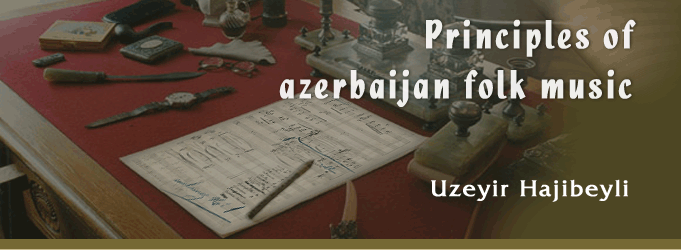

Part two
AUXILIARY MODES
5. Composing music in the mode "Saranj"
A. Diapason of the mode scale"Saranj"
The formula for building of the auxiliary mode scale "Saranj" is identical to that of the formula of the scale "Chargah" of the 2-nd type, i.e.1/2 - 11/2 - 1/2 + 1 - 1 - 1/2 . The only difference is that a full tone is formed between the last degree of the lower and the first degree of the upper tetrachords in "Chargah" of the 2- nd type, but in "Saranj" a semitone is formed only. The last degree of the lower tetrachord is a tonic of the mode. With the tonic mi of the first octave the scale of the auxiliary mode "Saranj" is presented in the following form:
B. Modal functions of degrees and permissible leaps
In the above scale the second degree has two functions standing in diametric opposition with regard to their importance. On the one hand, this degree is considered as an unstable supertonic in relation to the first degree of the scale. On the other hand, it is considered as a stable main tone in relation to the fourth and sixth degrees of the scale. Therefore, the functions of the other remaining degrees are defined, both in relation to the tonic, and in relation to the main tone. From this point of view:
1-st degree of the scale has a function of the lower quarte of the tonic, whilst also having the function of the subtonic of the main tone. A leap to the tonic is allowed from this degree.
2-nd degree of the scale has three functions: 1) function of the suppertonic of the lower quarte, 2) function of the main tone of the scale, and 3) function of the lower third of the tonic. As the main tone, leaps from this degree are allowed upwards to the third, the quarte, and the quinte.
3-rd degree of the scale has a function of the subtonic of the tonic. A leap from this degree is allowed to the supertonic of the keynote (diminished third).
4-th degree of the scale has a function of the tonic of the mode. Leaps from this degree arc allowed upwards - to the quinte of the main tone, downwards - to the main tone.
5-th degree of the scale has a function of the supertonic of the e mode keynote and the upper quarte of the main tone. Leaps from this degree are allowed: upwards - to the supertonic of the main tone quinte, downwards - to the main tone.
6-th degree of the scale has a function of the main tone quinte. Leaps are allowed downwards - to the tonic and main tone.
7-th degree of the scale has a function of the supertonic of the* main tone quinte. A leap from this degree is allowed to the upper quarte of the main tone.
8-th degree of the scale has a function of the boundary tone of the scale. Leaps are not allowed from this degree.
С. Table of permissible leaps
D. Full and half cadencesThe auxiliary mode "Saranj" resembles the mode "Segah" in the position of the tonic and community of ail degrees except the subtonic. Therefore, the full and half cadences of "Saranj" are the same as those of the mode "Segah".
[ Saranj: pages 1 2 ]| Chargah | Shahnaz | Saranj |

